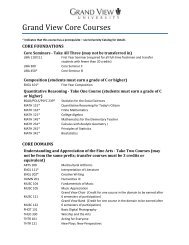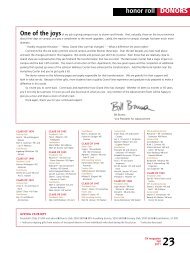MUNINN
MUNINN - Grand View University
MUNINN - Grand View University
- No tags were found...
You also want an ePaper? Increase the reach of your titles
YUMPU automatically turns print PDFs into web optimized ePapers that Google loves.
Lincoln v. Douglas <strong>MUNINN</strong> Volume 2 (2013)that often led to the subjugation of other people under the falsejustification of actually helping them. 4 Slaves were consideredcommodities to be exploited, traded, bartered, sold, and used. Theywere not considered free individuals but under laws concerningproperty rights. This dehumanization justified slavery in the minds ofmany Americans, just as the subjection of peoples in African and Asiawere justified to the British. Yet, there have also been opponents ofslavery from the beginning of this nation.Tensions between proponents and opponents of slaverybecame more acute with the Louisiana Purchase (1803). Although seenby some as a potential reservation to send Indians from eastern states,American settlement quickly followed the flag across the MississippiRiver. The Louisiana Purchase doubled the land of the United Statesand offered very cheap land opportunities to those who could mobilizethe labor to develop it. Though the actual costs of slavery are higherthan wage earners, slave labor could be moved quickly into the west,especially in areas with profitable cash crops such as cotton. 5 Thiswestward expansion of slavery accelerated the ideological divide andpolitical tension. The expansion of the United States yet again in thewake of the Mexican War (1846-1848) only added fuel to the fire.Organized abolitionist movements became common in the North by the1850s, which led to more and more political confrontations over thefuture of the Union.Compromises had been won between the free and slave statessince the framing of the constitution. By the mid-19 th century, the finalcompromise strategy was popular sovereignty. Popular sovereignty leftthe matter of slavery in the hands of the people of each state, ratherthan a decision made by people of the United States as a whole throughtheir representatives. Both methods are democratic, but popularsovereignty placed slavery squarely in the hands of statists rather thannationalists. Yet the issue over what was to be done with territoriesbefore and as they became states was still being debated. 6 In the shortrun, popular sovereignty led to the Free Soil movement (a politicalparty opposed to the expansion of slavery), the expansion of fugitiveslave laws (which called for Northerners to return runaway slaves totheir Southern owners), and the 1850 Compromise (which resulted inthe easing of a deadlock between Northern and Southern states by asomewhat mutually beneficial piece of legislation). 7 The long term4J. A. Hobson, Imperialism: A Study, reprint of the 1905 edition (New York: CosimoClassics, 2005), 3, 368. Editor’s note: Adam Smith made a similar conclusion on slaveryin his Wealth of Nations (1776).5Rothman, 70.6Richards, 66.7See William Harris, Lincoln’s Rise to the Presidency (Kansas: University Press ofKansas, 2007), 49; and Resolution introduced by Senator Henry Clay in Relation to theAdjustment of all Existing Questions of Controversy between the States arising out of the11







